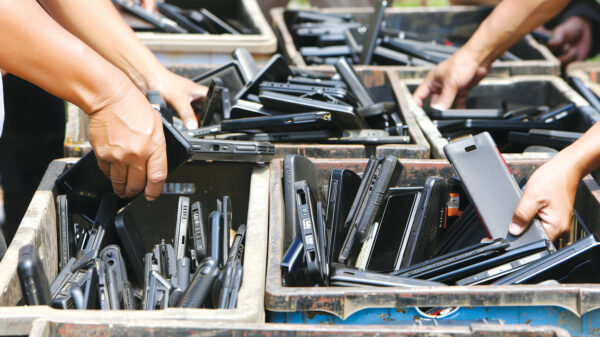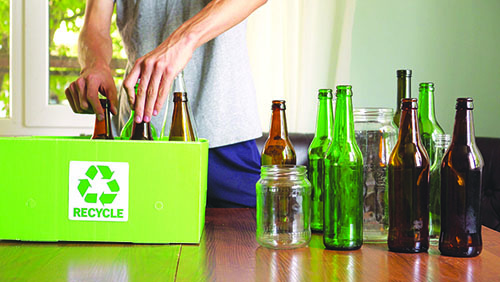Electronic waste is the fastest growing waste stream in the world, but manufacturers make it hard for individuals and businesses to keep their electronics in use longer. Right to Repair means people can fix more and waste less. Americans dispose of approximately 416,000 cell phones per day and only 15 to 20 percent of electronic waste is recycled.
The Right to Repair movement is all about making it easier and legal for people to fix the things they own, whether it’s a smartphone, a laptop or even a car or tractor. Currently, many manufacturers make it difficult for consumers and independent repair shops to access the tools, parts or instruction manuals needed to fix their products.
According to Stacy Savage, founder and chief executive officer of Zero Waste Strategies, Right to Repair laws do vary by state. Some states, like Massachusetts, have led the charge by passing laws that specifically cover vehicles or consumer electronics.
“It’s a patchwork of legislation at the moment, but the momentum is growing,” Savage said.
“One thing to note – President Biden issued an Executive Order in October 2023 supporting the Right to Repair movement, putting federal weight behind this issue. That means we could see national regulations develop that create a more uniform playing field, which would help recyclers plan for the future.”
Jon Brax, owner of Techable, explained that in its simplest form, the Right to Repair law ensures that consumers and independent repair shops can access the parts, tools, and documentation needed to fix their own devices.
“Currently, there’s no single federal mandate, so legislation varies from state to state – some states include a wide range of electronics, while others focus on specific categories like automotive or agricultural equipment,” Brax said. “Despite these differences, the core intention is the same: to make repairs more accessible and straightforward.”
Courtney Lytle Sarnow, partner at CM Law, an IP, technology and corporate law attorney and adjunct professor of law at Emory University, has done extensive work on right to repair laws.
As Sarnow explained, the Right to Repair is perhaps better understood as a movement than as a particular law. The basic concept is that consumers are being harmed by the increasing technical complexity of consumer goods from cell phones and cameras to cars and tractors. With the addition of computer chips to virtually all consumer goods, even simple cat toys, repair has become a predominantly technical matter rather than a mechanical one.
“As a result of the increase in complexity and many manufacturers’ use of software protection to keep operating systems proprietary, not only can normal consumers generally not repair the things they buy, but independent auto mechanics and similar businesses are being pushed to the verge of insolvency when they need to pay a significant annual license fee to each major brand in order to be able to get past the technical protections on the software that controls the product’s operation,” Sarnow said. In many cases, for instance, a mechanic can’t replace a water pump or air filter in a car without paying the manufacturer a license fee to be able to access the car’s operating system. The car generally won’t accept the new part without the license key and will disable the engine until the key is provided.
“The Right to Repair movement and advocacy groups try to restrict manufacturers’ right to protect their proprietary intellectual property in favor of the newly expressed “right” of consumers to be able to repair their many electronic and mechanical devices,” Sarnow explained.
The methods manufacturers use to keep their systems private and proprietary vary, but most manufacturers include various software anti-hacking codes in their systems, which are, in turn, re-enforced by Section 1201 of the Copyright Act prohibiting circumvention of these security codes. Some manufacturers also have adopted provisions in their warranties which void the warranty if the consumer makes any repairs other than through an authorized repair shop.
“In addition to the relevant federal laws, each state has the option to address these issues by passing state laws. There is a template for a Right to Repair statute written by an advocacy group (repair.org) that could be adopted by states or at a federal level,” Sarnow said. “There are a few states which have adopted a general R2R statute, like California, Oregon and New York and several more that have adopted a narrower version of the law, such as one which only applies to agricultural machinery and one which applies only to powered wheelchairs. A version of the Repair.org statute template has been introduced in Congress, but it is currently languishing in a committee until the topic in general attracts enough interest to motivate the members of Congress.”
Right to Repair & E-Waste
From an e-waste perspective, what impact could these Right to Repair laws potentially have on the level of e-waste generated?
“A huge one,” said Savage. “The more we can repair our devices, the longer we keep them in use, and that directly reduces the amount of e-waste we generate. Right now, the average American replaces their phone every two to three years, often because the battery dies, the screen cracks, or software updates slow down performance. If people had access to affordable repairs, and the know-how to complete them, they could keep those devices going for much longer.”
Savage also noted that e-waste is one of the fastest-growing waste streams in the world, and much of it contains hazardous materials like lead, mercury, arsenic and flame retardants.
“E-waste also contains precious metals, such as gold and nickel, and rare earth minerals, such as coltan,” Savage said. “When devices are tossed out instead of repaired, they either end up in landfills, where they can leach toxins into the environment, or they’re shipped overseas to be dismantled, typically using unsafe worker conditions. Let’s not forget that the value of the metals and earth minerals is also gone. Right to Repair laws can slow down this cycle by keeping products in circulation longer and making repair the first option, not the last.”
By ensuring easier access to parts and repair documentation, Brax said that Right to Repair laws can significantly prolong the usable life of electronic devices.
“Instead of discarding a product over a single faulty component, consumers can more readily fix their devices,” Brax said. “The result is fewer electronics heading to landfills and a reduction in overall e-waste.”
According to Sarnow, one of the effects of increasing consumer’s ability to choose repairs over replacement would be a direct reduction in the amount of e-waste. It is unclear whether this will have a significant impact or not, however.
“The movement focuses on making operating software open source instead of proprietary devices of all kinds. To the extent access to this software allows more repair, there could be a reduction in waste as people use their devices longer rather than replacing them frequently,” Sarnow said. “It is far from certain, however, that access to software is what keeps people from fixing their own phone or cars. Independent repair shops would certainly benefit, and an increase in repair options resulting from allowing independent shops to prosper rather than limiting repair to company-authorized providers could certainly help people keep devices operating longer. I would not expect a significant change in the amount of e-waste, but even a small improvement would be a good thing.”
So what is the trickle-down effect of the Right to Repair movement on the electronics recycling industry?
Ironically, although the Right to Repair movement definitely sees itself as aligned with environmental interests in decreasing waste, Sarnow said they actually refer negatively to recycling in the “Manifesto” (“Repair is better than recycling”).
“I think the intention was to encourage a less disposable philosophy for consumers in general, but it would be more helpful if they distinguished between recycling and throwing things in a landfill,” Sarnow said. “In general, the movement considers itself to be aligned with environmental concerns and refers frequently to reducing waste. They do not take the opportunity to promote recycling as much as they could; they share the goal of reducing landfill waste, but they focus on prolonging the life of devices rather than promoting recycling over landfills.”
Indeed, as Brax explained, with devices lasting longer, the total e-waste stream might decrease. However, e-waste recyclers could benefit by branching into related areas – like offering repair, refurbishment, or parts-harvesting services.
“These additional services can create new revenue streams and reinforce a commitment to a sustainable electronics management,” he said.
Savage added that if Right to Repair laws help extend product lifespans, recyclers might see fewer devices coming in as quickly. When electronics do reach the end of their life, they could be in better condition, making recovery of valuable materials easier and more efficient.
“Many e-waste recyclers also do refurbishing and resale, so stronger repair laws could actually help that side of their business grow,” Savage said. “If repair becomes more main stream, recyclers might have more opportunities to fix and resell devices instead of just dismantling them for scrap materials. At the end of the day, Right to Repair is about shifting our mindset from a throwaway culture to one where we value what we already have. For businesses in the recycling and waste reduction space, I’d say that’s a win-win.”
Published May 2025







